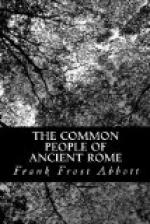These facts lend to the ancient Roman epitaphs their peculiar interest and charm. They give us a glimpse into the every-day life of the people which a Cicero, or a Virgil, or even a Horace cannot offer us. They must have exerted an influence, too, on Roman character, which we with our changed conditions can scarcely appreciate. We shall understand this fact if we call to mind the differences between the ancient practices in the matter of burial and our own. The village churchyard is with us a thing of the past. Whether on sanitary grounds, or for the sake of quiet and seclusion, in the interest of economy, or not to obtrude the thought of death upon us, the modern cemetery is put outside of our towns, and the memorials in it are rarely read by any of us. Our fathers did otherwise. The churchyard of old England and of New England was in the middle of the village, and “short cuts” from one part of the village to another led through its enclosure. Perhaps it was this fact which tempted our ancestors to set forth their life histories more fully than we do, who know that few, if any, will come to read them. Or is the world getting more reserved and sophisticated? Are we coming to put a greater restraint upon the expression of our emotions? Do we hesitate more than our fathers did to talk about ourselves? The ancient Romans were like our fathers in their willingness or desire to tell us of themselves. Perhaps the differences in their burial practices, which were mentioned above, tempted them to be communicative, and sometimes even garrulous. They put their tombstones in a spot still more frequented than the churchyard. They placed them by the side of the highways, just outside the city walls, where people were coming or going constantly. Along the Street of Tombs, as one goes out of Pompeii, or along the great Appian Way, which runs from Rome to Capua, Southern Italy and Brundisium, the port of departure for Greece and the Orient, they stand on both sides of the roadway and make their mute appeals for our attention. We know their like in the enclosure about old Trinity in New York, in the burial ground in New Haven, or in the churchyards across the water. They tell us not merely the date of birth and death of the deceased, but they let us know enough of his life to invest it with a certain individuality, and to give it a flavor of its own.




